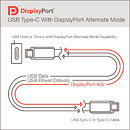- Joined
- Oct 9, 2007
- Messages
- 47,647 (7.44/day)
- Location
- Dublin, Ireland
| System Name | RBMK-1000 |
|---|---|
| Processor | AMD Ryzen 7 5700G |
| Motherboard | Gigabyte B550 AORUS Elite V2 |
| Cooling | DeepCool Gammax L240 V2 |
| Memory | 2x 16GB DDR4-3200 |
| Video Card(s) | Galax RTX 4070 Ti EX |
| Storage | Samsung 990 1TB |
| Display(s) | BenQ 1440p 60 Hz 27-inch |
| Case | Corsair Carbide 100R |
| Audio Device(s) | ASUS SupremeFX S1220A |
| Power Supply | Cooler Master MWE Gold 650W |
| Mouse | ASUS ROG Strix Impact |
| Keyboard | Gamdias Hermes E2 |
| Software | Windows 11 Pro |
The Video Electronics Standards Association (VESA ) today announced that it has released version 2.0 of the DisplayPort Alternate Mode ("Alt Mode") standard. DisplayPort Alt Mode 2.0 provides seamless interoperability with the new USB4 specification published by the USB Implementers Forum (USB-IF), and fully enables all of the features in the latest version of the DisplayPort standard (version 2.0) through the USB Type-C (USB-C) connector. With DisplayPort Alt Mode, the USB-C connector can transmit up to 80 Gigabits per second (Gbps) of DisplayPort video data utilizing all four high-speed lanes in the cable, or up to 40 Gbps with simultaneous SuperSpeed USB data delivery. VESA anticipates first products incorporating DisplayPort Alt Mode 2.0 to appear on the market in 2021.
DisplayPort 2.0, which was introduced in June 2019, provides up to a 3X increase in data bandwidth performance compared to the previous version of DisplayPort, as well as new capabilities to address future performance requirements of displays. These include beyond-8K resolutions, higher refresh rates and high dynamic range (HDR) support at higher resolutions, improved support for multiple display configurations, as well as improved user experience with augmented/virtual (AR/VR) displays, including support for 4K-and-beyond VR resolutions. Featuring the highly efficient 128b/132b channel coding shared with USB4, DisplayPort 2.0 delivers a maximum payload of 77.37 Gbps across four lanes (up to 19.34 Gbps per lane)—supporting ultra-high display performance configurations such as an 8K (7680x4320) display with 60 Hz refresh rate with full-color 30 bpp 4:4:4 HDR resolution uncompressed, and 16K (15360x8460) 60 Hz display with 30 bpp 4:4:4 HDR resolution with compression. With the release of DisplayPort Alt Mode 2.0, all of these high-performance video capabilities are now available to the USB ecosystem.


"VESA's updated DisplayPort Alt Mode spec includes a number of under-the-hood developments—including updates to interface discovery and configuration as well as power management—to ensure seamless integration with the USB4 specification," stated Craig Wiley, senior director of marketing at Parade Technologies, and VESA board member and DisplayPort Alt Mode sub-group leader. "This major undertaking, which was several years in the making, could only be made possible through the combined efforts of VESA and the USB-IF. Through our latest collaboration with the USB-IF, VESA is now taking care of everything related to high-performance displays over USB-C, whether through a native DisplayPort or USB-C connector, or through tunneling of DisplayPort over the native USB4 interface. DisplayPort is also tunneled through the Thunderbolt interface, making it the de facto video standard across PC and mobile displays."
"USB Type-C is becoming the connector of choice in notebooks and mobile solutions. With the new DisplayPort Alt Mode 2.0 specification, USB Type-C now delivers compelling single-connector solutions for docking, gaming, AR/VR HMDs, and professional HDR displays that combine 80 Gbps of video bandwidth and other important features of DisplayPort 2.0 with the transport of USB data and power delivery," said Syed Athar Hussain, VESA board vice chairman and display domain senior fellow, AMD.
"Intel's contribution of the Thunderbolt PHY layer specification to VESA for use in DisplayPort 2.0 was a significant milestone, and it underpins this new DisplayPort 2.0 Alt Mode specification to provide data rates up to 20 gigatransfers per second," said Jason Ziller, general manager, Client Connectivity Division at Intel. "This contribution ensures great user experiences by enabling today's most versatile port with the highest performing display capabilities."
View at TechPowerUp Main Site
DisplayPort 2.0, which was introduced in June 2019, provides up to a 3X increase in data bandwidth performance compared to the previous version of DisplayPort, as well as new capabilities to address future performance requirements of displays. These include beyond-8K resolutions, higher refresh rates and high dynamic range (HDR) support at higher resolutions, improved support for multiple display configurations, as well as improved user experience with augmented/virtual (AR/VR) displays, including support for 4K-and-beyond VR resolutions. Featuring the highly efficient 128b/132b channel coding shared with USB4, DisplayPort 2.0 delivers a maximum payload of 77.37 Gbps across four lanes (up to 19.34 Gbps per lane)—supporting ultra-high display performance configurations such as an 8K (7680x4320) display with 60 Hz refresh rate with full-color 30 bpp 4:4:4 HDR resolution uncompressed, and 16K (15360x8460) 60 Hz display with 30 bpp 4:4:4 HDR resolution with compression. With the release of DisplayPort Alt Mode 2.0, all of these high-performance video capabilities are now available to the USB ecosystem.


"VESA's updated DisplayPort Alt Mode spec includes a number of under-the-hood developments—including updates to interface discovery and configuration as well as power management—to ensure seamless integration with the USB4 specification," stated Craig Wiley, senior director of marketing at Parade Technologies, and VESA board member and DisplayPort Alt Mode sub-group leader. "This major undertaking, which was several years in the making, could only be made possible through the combined efforts of VESA and the USB-IF. Through our latest collaboration with the USB-IF, VESA is now taking care of everything related to high-performance displays over USB-C, whether through a native DisplayPort or USB-C connector, or through tunneling of DisplayPort over the native USB4 interface. DisplayPort is also tunneled through the Thunderbolt interface, making it the de facto video standard across PC and mobile displays."
"USB Type-C is becoming the connector of choice in notebooks and mobile solutions. With the new DisplayPort Alt Mode 2.0 specification, USB Type-C now delivers compelling single-connector solutions for docking, gaming, AR/VR HMDs, and professional HDR displays that combine 80 Gbps of video bandwidth and other important features of DisplayPort 2.0 with the transport of USB data and power delivery," said Syed Athar Hussain, VESA board vice chairman and display domain senior fellow, AMD.
"Intel's contribution of the Thunderbolt PHY layer specification to VESA for use in DisplayPort 2.0 was a significant milestone, and it underpins this new DisplayPort 2.0 Alt Mode specification to provide data rates up to 20 gigatransfers per second," said Jason Ziller, general manager, Client Connectivity Division at Intel. "This contribution ensures great user experiences by enabling today's most versatile port with the highest performing display capabilities."
View at TechPowerUp Main Site





